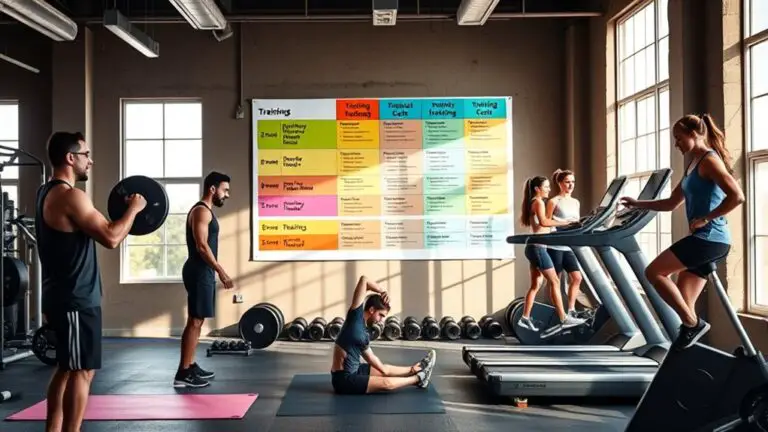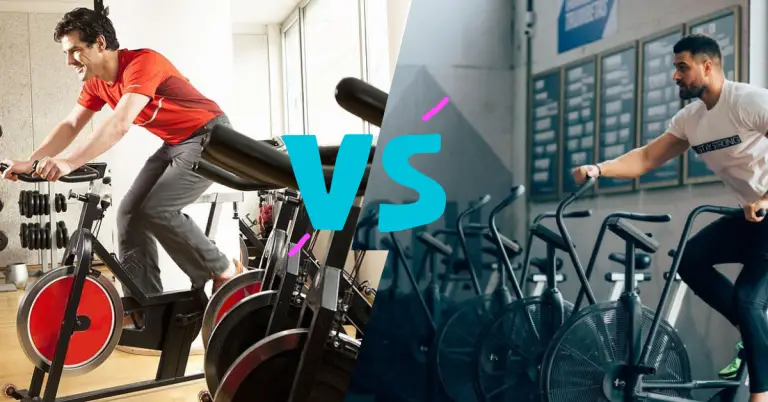The Best Gym Workouts for Seniors to Stay Fit
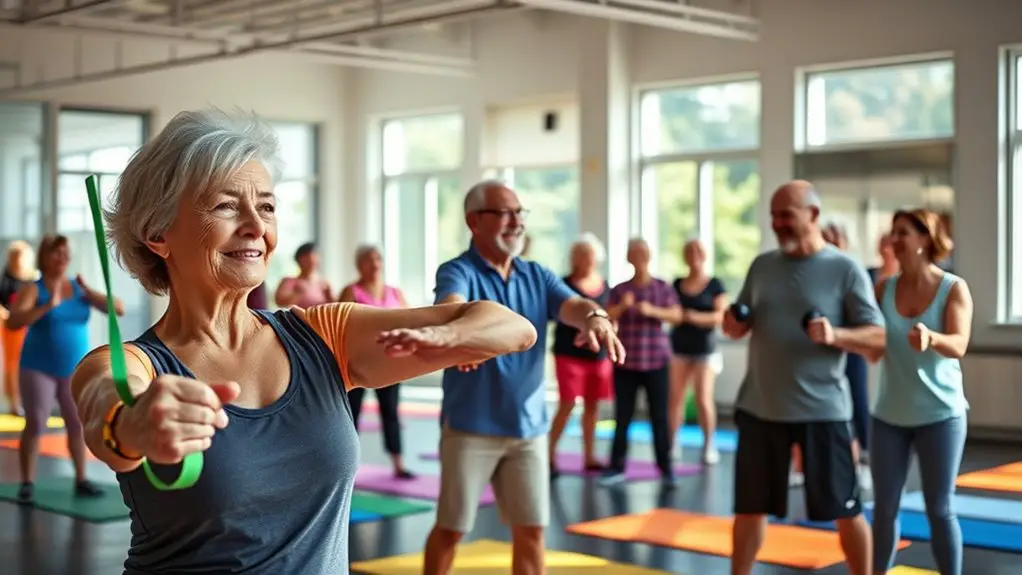
The best gym workouts for seniors focus on safe, effective exercises that enhance strength, flexibility, and cardiovascular health. Low-impact cardio, like walking or cycling, minimizes joint stress. Incorporate strength training to maintain muscle mass and improve balance. Flexibility workouts, such as gentle yoga or tai chi, promote stability and reduce stiffness. Group classes can make fitness enjoyable and social. Keep progressing steadily, and you’ll discover even more tailored strategies to help you stay fit and healthy.
Understanding the Importance of Fitness for Seniors
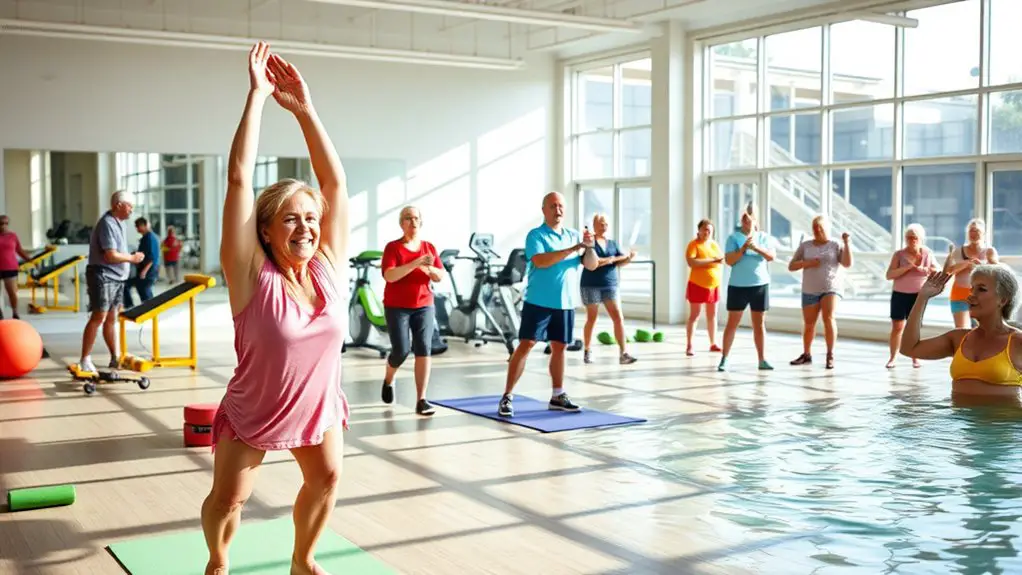
As you age, staying fit becomes essential for maintaining your health and independence. Many people hold fitness misconceptions, believing that exercise is risky or only for the young. In reality, regular physical activity can provide numerous health benefits, including improved balance, increased strength, and enhanced mental well-being. Engaging in safe, tailored workouts can help you avoid injuries and boost your confidence.
It’s important to recognize that fitness isn’t about intense workouts; it’s about finding what works for you. Simple strength training and flexibility exercises can make a big difference in your daily life. Additionally, staying fit can prevent chronic diseases, improve mobility, and enhance your overall quality of life. So, don’t let misconceptions hold you back. Embrace a fitness routine that prioritizes safety and aligns with your personal goals. You’ll not only feel better physically but also enjoy a more active, fulfilling lifestyle. Incorporating effective cardio workouts like skipping rope can also enhance your routine and promote weight loss.
Low-Impact Cardio Exercises
Low-impact cardio exercises are a fantastic way for you to stay active without putting too much strain on your joints. They offer numerous benefits, including improved heart health and enhanced endurance. Let’s explore some recommended exercises and tips to help you work out safely and effectively.
Benefits of Low-Impact Cardio
While you may think high-intensity workouts are the only way to stay fit, low-impact cardio offers a range of benefits, especially for seniors. These exercises help maintain your heart health and enhance joint mobility, making them perfect for a safer workout routine.
Here are some key benefits of low-impact cardio:
- Reduces stress on joints
- Improves endurance and stamina
- Promotes better heart health
- Enhances overall mobility
- Encourages consistent exercise habits
Recommended Exercises for Seniors
Maintaining an active lifestyle is key for seniors, and incorporating low-impact cardio exercises can make a significant difference. Chair exercises are a fantastic option, as they allow you to engage in movement while providing support. Simple activities like seated leg lifts or arm raises can get your heart rate up without straining your joints.
Aquatic workouts are another great choice. Exercising in water reduces impact and makes movements easier on your body. Water aerobics or gentle swimming can enhance your cardiovascular fitness while promoting flexibility and strength.
Both options offer a safe way to stay active, so you can enjoy the many benefits of exercise without risk. Remember, it’s always wise to consult a healthcare professional before starting any new workout routine.
Tips for Safe Workouts
To guarantee your workouts are safe and effective, it’s essential to listen to your body and make adjustments as needed. Incorporating low-impact cardio exercises can enhance your fitness while minimizing the risk of injury. Consider these tips for safe workouts:
- Always start with warm up routines to prepare your muscles.
- Choose activities like swimming, cycling, or walking that are gentle on your joints.
- Stay hydrated before, during, and after your workout.
- Use proper equipment and footwear for support and stability.
- Pay attention to any discomfort and stop if you feel any pain.
Strength Training for Enhanced Muscle Health
Strength training is essential for maintaining muscle health as you age. It not only boosts your strength but also helps improve balance and reduce the risk of injury. By using safe exercise techniques, you can enjoy the many benefits of resistance training without overexerting yourself.
Benefits of Resistance Training
Resistance training offers seniors a powerful way to enhance muscle health and improve overall well-being. By incorporating this type of exercise into your routine, you can enjoy various benefits, including:
- Muscle preservation: Helps maintain lean muscle mass as you age.
- Joint health: Strengthens the muscles around joints, providing better support and stability.
- Increased metabolism: Boosts your metabolism, aiding in weight management.
- Improved balance: Enhances coordination and reduces the risk of falls.
- Enhanced mood: Releases endorphins, improving your overall mental health.
With proper guidance and safety precautions, resistance training can be an essential part of your fitness journey. Embrace it to enjoy a healthier, more active lifestyle, while also taking care of your body.
Safe Exercise Techniques
While engaging in strength training can greatly enhance your muscle health, it’s vital to prioritize safety to prevent injuries. Start with lighter weights and focus on proper form—this helps guarantee you’re using the right muscles and reduces strain. Don’t hesitate to use exercise modifications to match your current fitness level; this can make a significant difference in your training effectiveness and safety. Always warm up before starting your workout and cool down afterward to support recovery. Additionally, listen to your body; if something doesn’t feel right, stop and reassess. Incorporating these practices not only fosters injury prevention but also boosts your confidence as you progress in your strength training journey. Stay safe and enjoy your workouts!
Flexibility and Balance Workouts
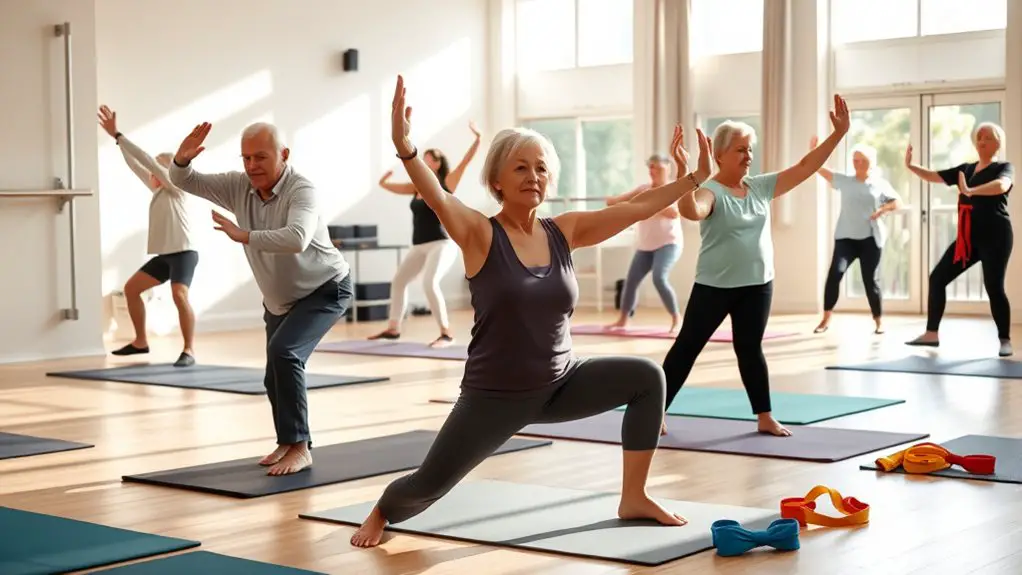
As you age, maintaining flexibility and balance becomes essential for overall health and mobility. Engaging in workouts that focus on these areas can greatly enhance your daily life. Incorporating activities like yoga stretches and tai chi can provide a gentle yet effective way to improve your flexibility and stability.
Here are some safe exercises you can try:
- Gentle yoga stretches to improve flexibility and reduce stiffness.
- Chair yoga for added support while stretching.
- Tai chi movements to enhance balance and coordination.
- Ankle circles to strengthen lower legs and improve stability.
- Balance exercises, such as standing on one leg, using a wall for support.
Remember to always start slow and listen to your body. These exercises not only promote physical well-being but also contribute to mental relaxation, making them perfect for seniors looking to stay fit safely.
Group Classes and Social Fitness Opportunities
Participating in group classes can be a fantastic way for seniors to stay active while enjoying the camaraderie of others. These classes foster positive group dynamics, making workouts feel less intimidating and more engaging. You’ll find that sharing the experience with peers creates a supportive fitness community, where everyone encourages one another.
Group classes often include low-impact options like yoga, water aerobics, or gentle strength training, ensuring safety while still providing effective workouts. Instructors are trained to accommodate various fitness levels, so you can feel confident that your needs are being met.
Plus, the social aspect can lift your spirits and motivate you to stick with your fitness routine. As you build friendships and enjoy shared goals, staying active becomes more enjoyable. So, consider joining a group class; it’s not just about fitness—it’s about connecting with others and having fun while you stay fit!
Tips for Staying Motivated and Safe
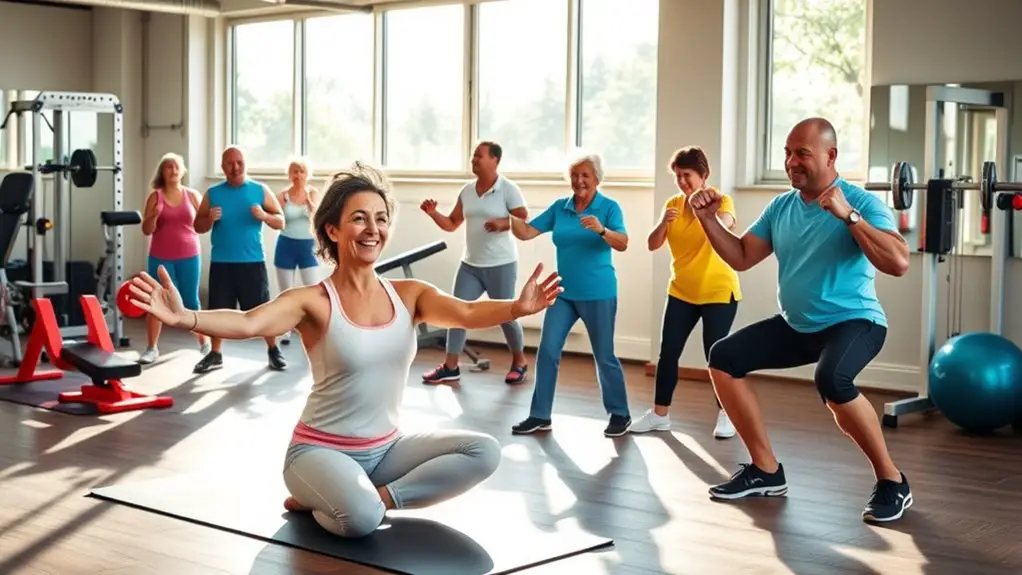
Staying motivated and safe during your workouts is essential for maintaining a consistent fitness routine. Here are some effective motivation techniques and safety precautions to keep in mind:
- Set realistic goals: Break your fitness objectives into smaller, achievable milestones.
- Track your progress: Use a journal or app to monitor your workouts and celebrate your achievements.
- Choose enjoyable activities: Engage in exercises you love to make your workouts something you look forward to.
- Workout with a partner: Exercising with a friend can boost your motivation and guarantee you’re both safe.
- Listen to your body: Pay attention to any discomfort or pain, and don’t hesitate to adjust your routine as needed.
Frequently Asked Questions
What Should Seniors Wear to the Gym for Comfort and Safety?
When you’re heading to the gym, comfort and safety should be your top priorities. Choose gym attire that’s breathable and allows for easy movement, like moisture-wicking shirts and stretchy pants. For your footwear choice, opt for supportive sneakers with good grip to help prevent slips and falls. Avoid loose clothing that could get caught in equipment, and consider layers if the gym temperature varies. Staying comfortable and safe will enhance your workout experience!
How Can Seniors Track Their Fitness Progress Effectively?
To track your fitness progress effectively, consider using fitness apps that allow you to log workouts and monitor your activity levels. They often come with features that help you set goals and receive reminders. Alternatively, keeping a progress journal can be a great way to note your achievements and feelings after each session. Whichever method you choose, make certain it feels comfortable and safe for you, making it easier to stay motivated on your fitness journey.
Are There Specific Gym Machines That Are Safer for Seniors?
When considering gym machines that are safer for you, look for those designed for circuit training and strength training. Machines with built-in safety features, like adjustable weights and guided movements, can minimize the risk of injury. Options like seated leg presses and chest presses offer support while you work on building strength. Always consult with a fitness professional to guarantee you’re using the machines correctly and safely, tailored to your needs.
How Often Should Seniors Work Out Each Week?
You should aim for exercise frequency of at least 150 minutes a week, spread across several days. This can be broken down into 30-minute sessions, five times a week. Incorporating workout variety, like strength training, balance exercises, and cardio, can keep things interesting while promoting safety. Always listen to your body and take rest days if needed. It’s important to consult with a healthcare professional before starting any new exercise routine.
What Should Seniors Do if They Experience Pain During Workouts?
When the going gets tough, it’s wise to listen to your body. If you experience pain during workouts, don’t push through it. Focus on pain management by taking a break and evaluating the situation. Consider workout modifications—like reducing intensity or switching exercises—to guarantee you stay safe. Consulting a fitness professional or your doctor can also help tailor your routine, making certain you stay in the game without risking injury.
